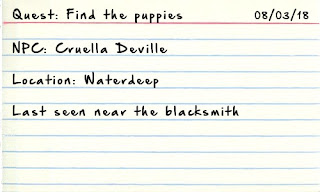Campaigns have lots of moving parts. There are likely dozens of NPCs, a couple main quest hooks, and several side quest hooks. There are also clues, rumors, random bits of lore, and locations of significance that your players will stumble upon over the course of months. It's hard enough to remember what happened in the game 2 sessions ago, much less 3 or 4 months ago.
 |
| Notes in a quest log can be short and sweet. |
How do they keep track of all of that?
The Quest Log
One of the biggest player challenges (and probably one of the simplest to solve) revolves around player note-taking. Ideally, there's at least one player at the table who is keeping a set of notes written and organized for easy reference... And yet, remembering (or finding) the information the PC's need, even when there are extensive notes, is often still a chore.
One of my players keeps extraordinarily detailed notes. So detailed that the Google document is now dozens and dozens of pages long. I think he may be planning a novelization... But even with such extensive notes, something as simple as finding all the recent NPC hooks is a daunting task.
To simplify the burden, the GM should keep some simple colored index cards on hand during the sessions. Each time the PCs get an clue, plot, or quest hook, simple jot a couple quick notes down an hand it to the player. It's as easy a 4 lines.
Short hook description, NPC name, NPC location, notes... Perhaps a date stamp for organization. If you use a variety of colors, you can even use the card's color as part of the organization. Yellow for NPC quests, pink for plot clues, blue for interesting locations (with no specific quest attached)... Or anything along those lines.
EDIT: For those that use a wiki and/or notebook, this method would not necessarily replace those notes, but enhance them with a stack of quest cards right at the table during play for easy reference.
Again, keep it short and simple. The idea is not for you to write all their notes for them, but to give them an easily organized visual reference for specific hooks to which they can add more notes. It should take no more than a minute or two to jot the quest or plot hook down, and your players will have a quick reference for all sorts of happenings in your game world.

